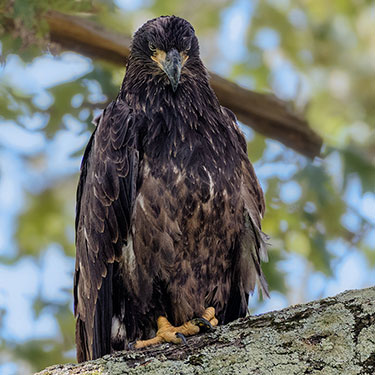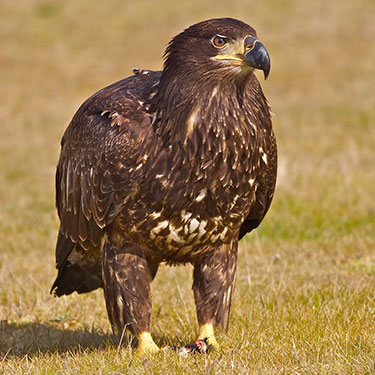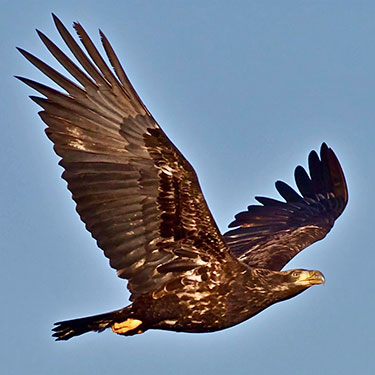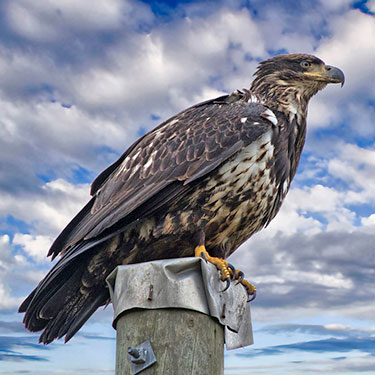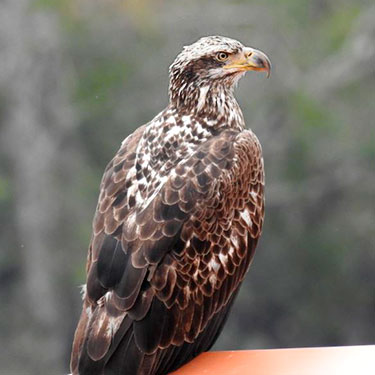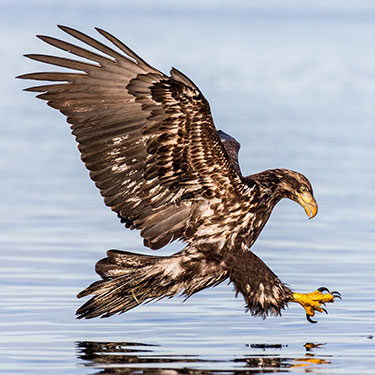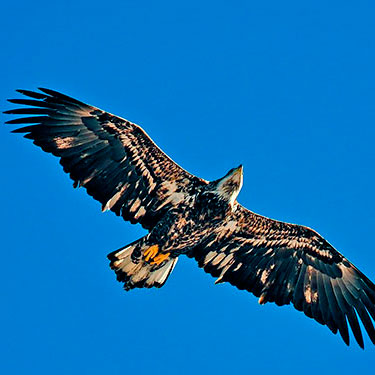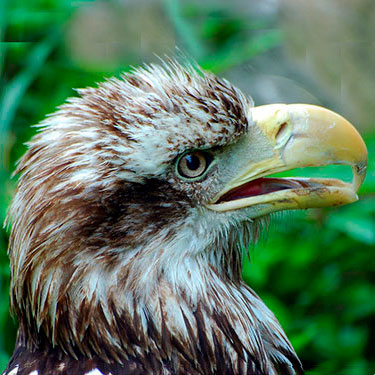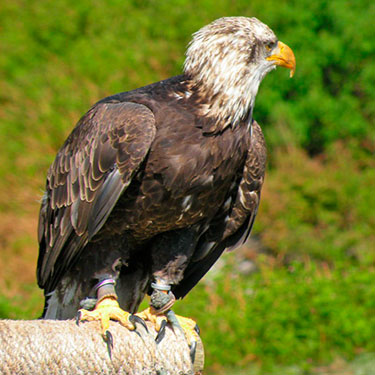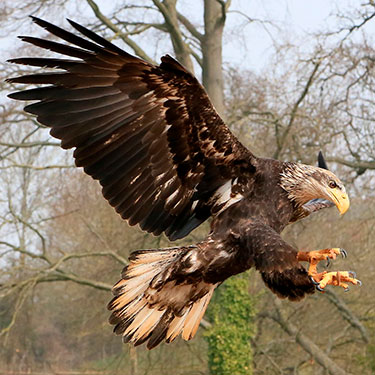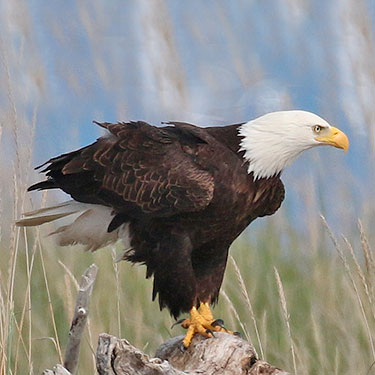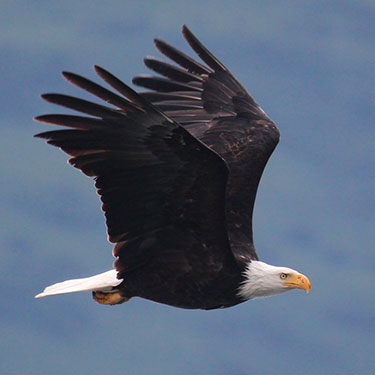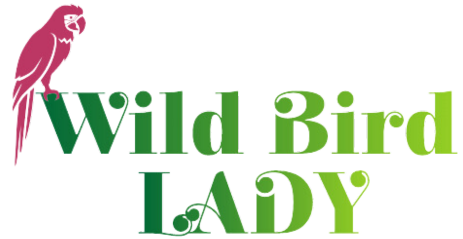Introduction
If you’ve ever seen a massive, dark-colored bird soaring high above the treetops or perched solemnly near a lake, chances are you’ve encountered a juvenile eagle. But was it a juvenile bald eagle or a juvenile golden eagle? Without the trademark white head and tail, even experienced birders can hesitate before making the call.
Identifying young eagles is one of the trickiest challenges in birdwatching. Juvenile bald eagles look nothing like their adult counterparts. And to complicate matters, their appearance overlaps with that of juvenile golden eagles, which are equally majestic but subtly different.
In this in-depth guide, we’ll explore:
- What a juvenile bald eagle looks like at each stage
- How to tell it apart from a juvenile golden eagle
- Behavioral traits, habitat, and more
- Tips for confident identification in the field
Let’s sharpen your eagle-spotting skills.
What Is a Juvenile Bald Eagle?
A juvenile bald eagle refers to a bald eagle that has left the nest but hasn’t yet developed adult plumage — usually up until it’s about 5 years old. These “young bald eagles” go through several plumage stages before earning their signature white heads and yellow beaks.
If you’re expecting to see a white head and tail right away, you’re in for a surprise — juvenile bald eagles look very different from the national bird you may be picturing.
How to Identify a Juvenile Bald Eagle
Here’s how you can confidently identify a juvenile bald eagle in the field.
1. Plumage and Coloration
In their early years, juvenile bald eagles appear:
- Mostly dark brown across the body, wings, and head
- With irregular white blotches on the underside of wings, belly, or legs
- Their tail is dark, often mottled with white patches (not the clean white of adults)
- The head is also dark, sometimes appearing slightly lighter brown by year 2–3
The plumage is mottled and uneven — think of it as a “messy” version of their final form.
🧠 Quick Fact: These young birds are sometimes mistaken for vultures due to their brown color, but bald eagles fly with flat wings, not in a V-shape like turkey vultures.
2. Beak and Eye Color
- Juvenile beak: Dark gray to black
- Adult beak: Bright yellow
- Juvenile eyes: Deep brown
- Adult eyes: Pale yellow
These gradual changes in soft-part coloration are excellent age indicators, especially at close range.
3. Size and Shape
Juvenile bald eagles are:
- Massive, even compared to adults — they may appear bulkier due to fluffier feathering
- Wingspan: 6.5 to 8 feet
- Body length: 30–37 inches
- Females are noticeably larger than males (as with many raptors)
Look for a broad-shouldered, powerful silhouette when soaring — with slightly upturned “fingers” at the wing tips.
Quick Comparison: Adult vs. Juvenile Bald Eagle
| Feature | Adult Bald Eagle | Juvenile Bald Eagle |
|---|---|---|
| Head Color | Bright white | Dark brown (gradually lightens with age) |
| Tail Color | White | Dark with mottled white |
| Beak Color | Bright yellow | Black to grayish-yellow |
| Eye Color | Pale yellow | Dark brown |
| Body Color | Uniform dark brown | Mottled brown and white |
| Wingspan | 6 to 8 feet | Same (full wingspan from fledging) |
Year-by-Year Plumage Guide for Juvenile Bald Eagles
Juvenile to 1 1/2 Year
Juvenile bald eagles leave the nest with a dark brown plumage. This plumage is the darkest and least variable of all the subsequent young bald eagle plumages.
Fledging juveniles keep this plumage for about 6 months before beginning to molt into another plumage. The coloration of bare parts (beak, face, legs, and feet) also begins to change after the first 6 months after leaving the nest.
A first-year eaglet is entirely dark brown with white flecking on the wing’s underside, axillaries, and belly.
This is the plumage an eaglet leaves the nest in.
The juvenile plumage is the least variable among non-adult plumages.
Fledgling birds show a blackish-brown breast that may contrast with the lighter-colored belly.
After six months, the immature eagle begins to turn light brown.
More white flecking begins to appear on the breast and the underwing.
The beak and cere are blackish.
By the end of the first 1 1/2 year, the beak begins to turn colors, but this is variable, with some birds keeping their dark beaks well into the second year.
In flight, a 1 ½-year-old eagle may show an increasing but variable amount of white flecking.
The wings of a first-year bird are wider and have a more “rounded” trailing edge.
2 1/2 Years
The 2 ½ years of age includes some of the most variable plumage stages of immature bald eagles. Some birds can remain relatively dark with white flecking, while others can have a mostly white belly with brown flecking.
The plumage pattern combinations in between can be confusing and useless to age an immature bald eagle other than saying that the bird is about 2 ½ years of age.
A common field mark during this age period is a dark breast that contrasts with a paler throat and belly.
The legs also become more yellow.
Another field mark is a whitish inverted triangular patch on the mantle.
The eyes (iris) continue turning lighter brown.
The bill begins to turn yellow-brown.
During the immature stage, the pattern and amount of white flecking and mottling are rather variable, making it difficult to tell the age of the immature bald eagle.
Some birds show a whitish tail with what appears to be a brown terminal tail band.
In flight, a 2 ½ year-old bird shows heavy white flecking and mottling on the underwings, the back, and belly. Some birds show a dingy white belly.
Some birds show a jagged trailing edge resulting from old and new shorter wing feathers.
3 1/2 Years
The year 3 ½ marks the transition to the typical adult plumage. The white mottling of the underwing coverts and belly begin to darken while the head and tail begin to turn white with much brown flecking.
Some ornithologists call 3 ½ year-old birds sub-adults.
At 3 ½ years-old, the head and tail begin to turn white brown flecking.
An important field mark of Sub-adult bald eagles is a conspicuous dark band or patch through and behind the eye.
The bill is mostly yellow. Some individuals show brown streaks or lines on the culmen or top of the beak.
The eyes (iris) are light brown but not nearly as pale as in an adult bird.
In flight, a 3 ½ year-old bird resembles an adult with a dingy white head and tail.
The contour or body plumage turns increasing homogenously dark brown.
4 1/2 to 5 1/2 or Definitive
During the 4 ½ to definitive plumage period, bald eagles acquire the adult plumage. The head, neck, tail, and upper and undertail coverts turn white, and the body turns dark brown.
A 4 ½-year-old bird may still show a few brown flecking on the tail and head, which are progressively lost.
Only approximately 25% of the birds acquire the adult plumage at the age of 4 ½ years, but all or 100% of bald eagles acquire the pure white head and tail adult plumage at the age of 5 ½ years.
Once a bald eagle acquires the adult plumage, this is kept throughout the life of the bird.
The head acquires the pure white but may show some brown flecking. Some birds take up 8 years to acquire a pure white head and neck, but most do it in 5 ½ years.
The bill is now bright yellow.
The eyes (iris) are yellowish-white. The legs become bright yellow.
The tail turns overall white but still may show some brown flecking, in some individuals.
Some birds take a few more years to acquire a pure white tail and tail coverts.
In flight, a 5 ½ year-old bird shows the adult bald eagle plumage.
While the head, neck, and tail may still show some brown streaks, these are only noticeable at close range.
Don’t Be Fooled: Juvenile Bald Eagle vs. Juvenile Golden Eagle
Now for the most common confusion among birders: juvenile bald eagles and juvenile golden eagles. Both are large, dark raptors with brown feathers and white patches — but the details differ.
Key Differences at a Glance
| Feature | Juvenile Bald Eagle | Juvenile Golden Eagle |
|---|---|---|
| Wing Pattern | Irregular white blotches | Clean, distinct white patches at wing base |
| Tail | Mottled with white | White base with dark band at tip |
| Head Color | Dark brown, may lighten | Uniform dark with golden nape |
| Body Build | Bulkier, heavier chest | More slender and streamlined |
| Habitat | Near lakes, rivers, coasts | Mountains, deserts, open plains |
| Flight Style | Soars with flat wings | Soars with slightly uplifted wings |
📸 Visual Tip:
- A juvenile golden eagle has a clean, sharp contrast between the dark wing tips and white wing patches.
- A juvenile bald eagle looks more “splotchy” and less sharply defined.
Where You’re Most Likely to Spot Each Species
Juvenile Bald Eagle:
- Coastal regions
- Large lakes and reservoirs
- Wetlands and river valleys
- Northern states and Alaska in summer; southern U.S. in winter
Juvenile Golden Eagle:
- Rocky Mountains
- Western deserts and plains
- Open grasslands and canyons
- Typically found farther inland
🧭 Use location and habitat to help confirm your ID. If you’re by a lake, chances are higher it’s a young bald eagle.
Behavior Differences
While both juvenile eagles soar and hunt, their behavior can also offer clues.
Juvenile Bald Eagles:
- Often seen perched near water
- Scavenge frequently — including roadkill and fish remains
- May follow adult eagles or other raptors to food sources
Juvenile Golden Eagles:
Spend time gliding in thermals across mountain slopes
More solitary and elusive
Hunt live prey (rabbits, ground squirrels) more than they scavenge
What Do Juvenile Bald Eagles Eat?
A young bald eagle’s diet isn’t so different from the adult — but they’re often less skilled at hunting early on, so scavenging plays a bigger role.
Common foods include:
- Fish (their favorite, if they can catch it!)
- Carrion (dead animals, especially during winter)
- Ducks, gulls, or other waterfowl
- Mammals (rabbits, muskrats, squirrels)
They often hang around landfills, rivers, or eagle-rich areas to learn from older birds — like nature’s version of apprenticeship.
Fun Facts About Juvenile Bald Eagles
- 🐣 They can fly over 400 miles in a single day during dispersal flights.
- 🦴 They may scavenge on roadkill or join vultures during lean seasons.
- 📦 Juvenile bald eagles have been tracked visiting landfills, airports, and fish farms.
- 🧬 Their DNA is identical to adults — it’s only plumage and age that make them different.
- 🗓️ Some take up to 6 years to gain full adult plumage in rare cases.
Tips for Photographing Juvenile Bald Eagles
- Use a telephoto lens (400mm+) to keep distance without disturbance
- Catch them in flight to highlight underwing patterns
- Watch for them near carrion or fish-rich areas
- Try winter roosts or migration hotspots for best chances
Why It Matters: The Conservation Angle
Recognizing juvenile bald eagles isn’t just fun — it’s important.
- Monitoring juvenile populations helps scientists assess species health
- Avoiding misidentification ensures accurate birding reports and conservation data
- It educates the public that not all bald eagles look the same — especially young ones
The bald eagle was once on the brink of extinction, with fewer than 500 nesting pairs in the 1960s. Today, their numbers have rebounded thanks to legal protections and conservation awareness — and that includes understanding their youth.
How to Help Juvenile Bald Eagles Thrive
Want to support these majestic raptors?
✅ Keep waterways clean
Pollution, especially lead and mercury, affects fish — the bald eagle’s primary food source.
✅ Avoid rodenticides and pesticides
These toxins travel up the food chain and harm young eagles.
✅ Support habitat conservation
Forested riverbanks, old-growth trees, and protected flyways help sustain populations.
✅ Report sightings
Contribute to platforms like eBird or local conservation groups to track juvenile populations.
Final Thoughts
Spotting a juvenile bald eagle is an unforgettable experience — not just for its grandeur, but for the story it tells. These young raptors are in transition, not yet adorned with the regal white head but already commanding the skies with power and grace.
Learning to identify a juvenile bald eagle — and not mistake it for a juvenile golden eagle — takes practice, patience, and attention to detail. But once you’ve seen the difference, you’ll never unsee it.
So next time you see a mottled brown eagle soaring above a river or scavenging near a lake, you’ll know exactly what you’re looking at: a future monarch of the skies.
Frequently Asked Questions (FAQ)
1. What does a juvenile bald eagle look like?
A juvenile bald eagle is mostly dark brown with irregular white patches on its belly, underwings, and tail. It does not have the iconic white head and tail of an adult. The beak is dark or grayish-yellow, and the eyes are brown. It takes up to five years to develop full adult plumage.
2. At what age do bald eagles get their white heads?
Bald eagles typically gain their fully white head and tail feathers by age five, although some may appear almost adult-like by age four. Until then, they go through mottled plumage stages.
3. Are juvenile bald eagles bigger than adults?
In terms of body size and wingspan, juveniles are nearly the same as adults once they fledge. However, they may appear larger in flight due to fluffier feathers and lack of sleek adult feathering.
4. Do juvenile bald eagles migrate?
Yes. Many juvenile bald eagles migrate long distances after leaving the nest. They often travel hundreds or even thousands of miles during their first fall and winter in search of food and habitat.
5. Can juvenile bald eagles breed?
No. Juvenile bald eagles do not breed. Bald eagles typically reach sexual maturity and begin breeding at age 4 to 5, once they have full adult plumage and stable territory.
6. Where can I see juvenile bald eagles in the wild?
Look for them near lakes, rivers, reservoirs, and coasts across North America — especially in the Pacific Northwest, Great Lakes, Florida, and Alaska. Juveniles are often seen during migration or wintering seasons.
7. What do juvenile bald eagles eat?
Like adults, juveniles eat fish, waterfowl, small mammals, carrion, and even roadkill. They’re opportunistic and may scavenge or steal food from other birds (a behavior called kleptoparasitism).
8. How long does a bald eagle stay a juvenile?
A bald eagle is considered juvenile or immature until it reaches about 4–5 years old. During that time, its plumage gradually changes each year until it becomes a full adult.
Latest Posts
How to Identify a Baby Cardinal: Color, Sounds, and Behavior Explained
Introduction: Meet the Baby Cardinal If you’ve ever spotted a tiny, fluffy bird with a barely-there crest hopping around your backyard and wondered, “Is that a baby cardinal?”—you’re not...
What Do Pigeons Eat? The Ultimate Guide to a Healthy Pigeon Diet
Pigeons are everywhere—from bustling city sidewalks to serene countryside barns. But have you ever stopped to wonder: What do pigeons eat? Whether you're a bird enthusiast, a new pigeon keeper, or...


